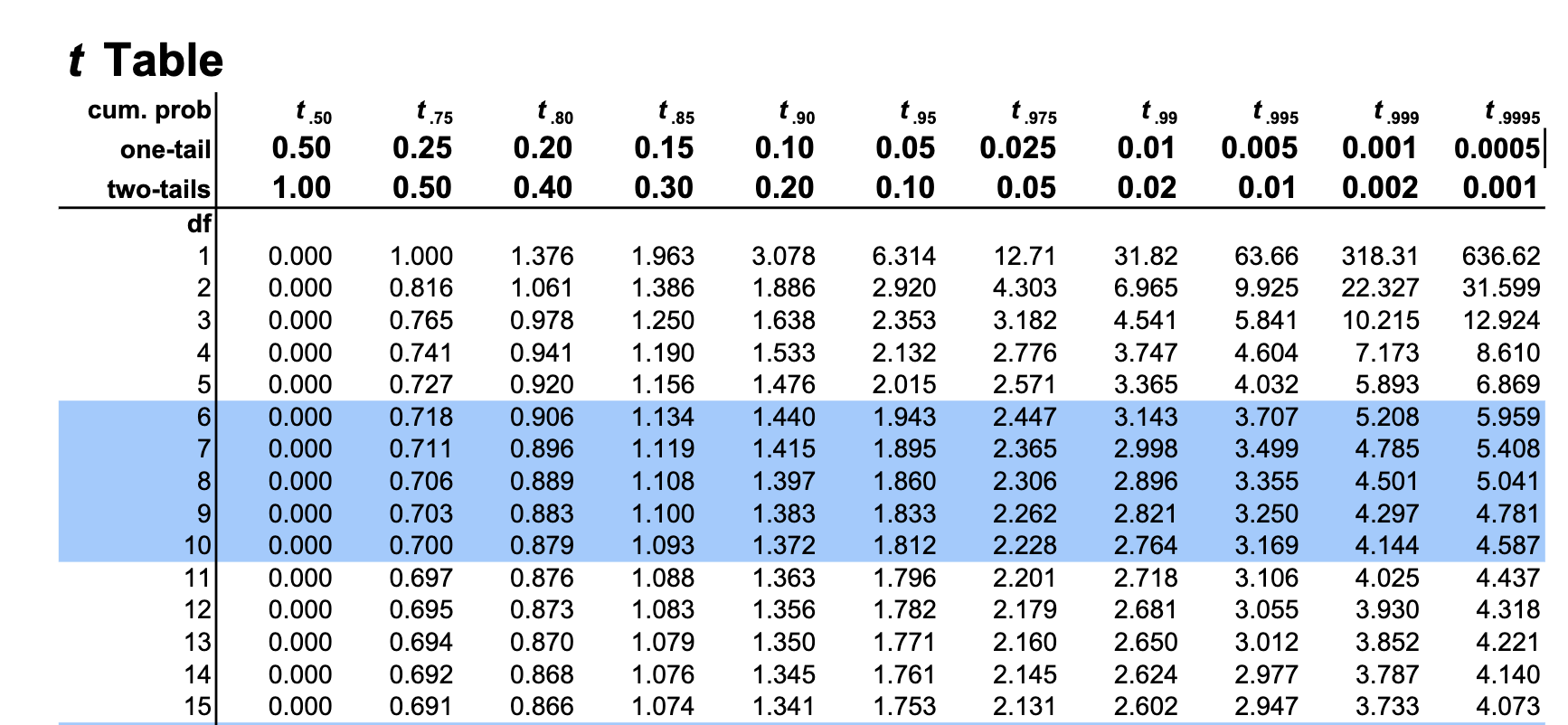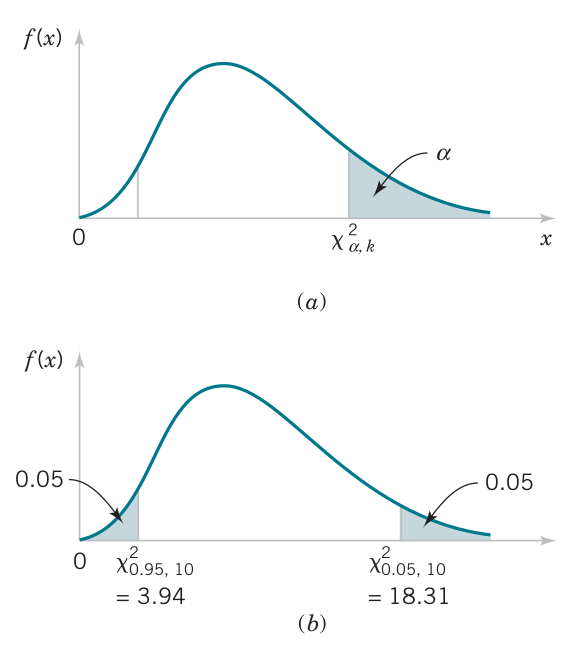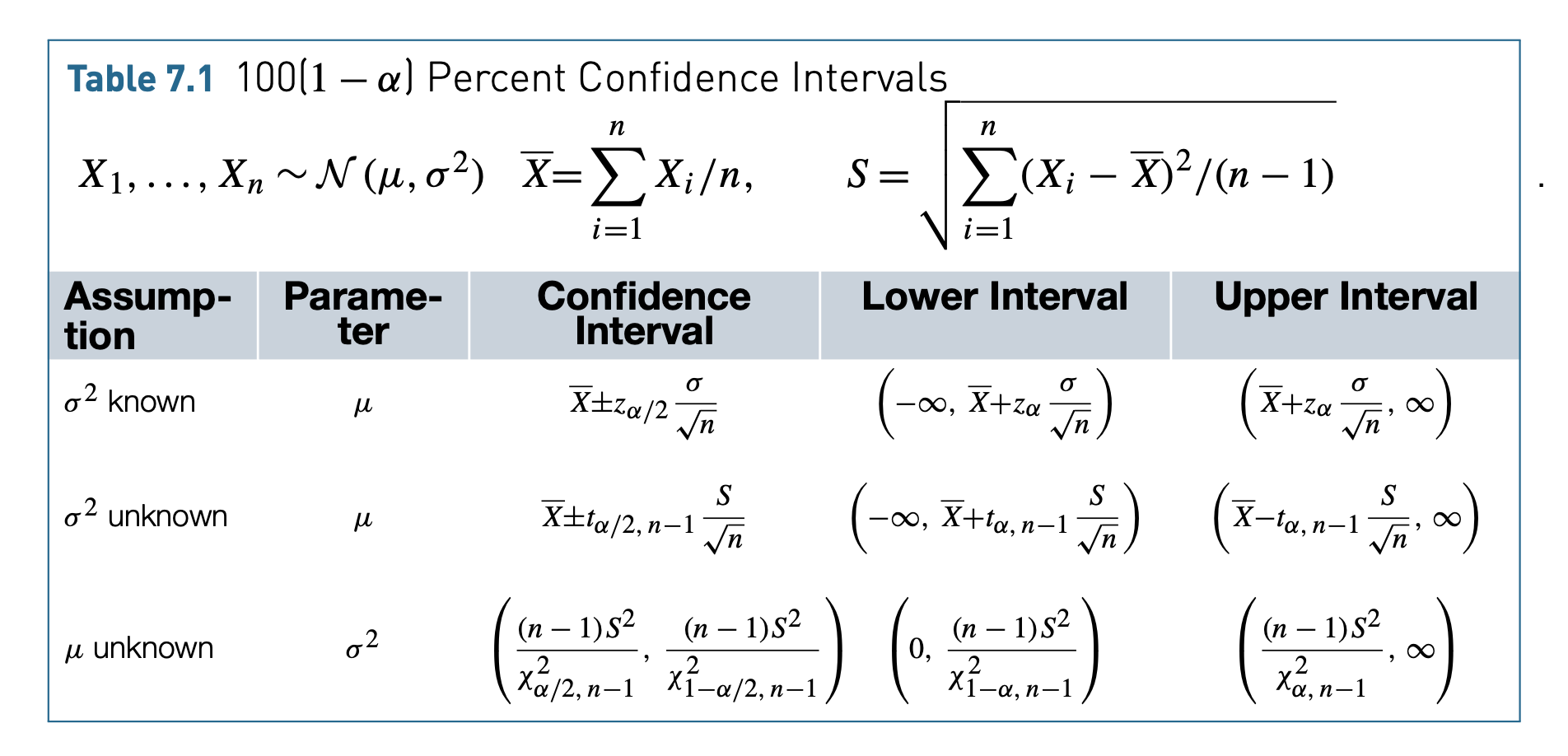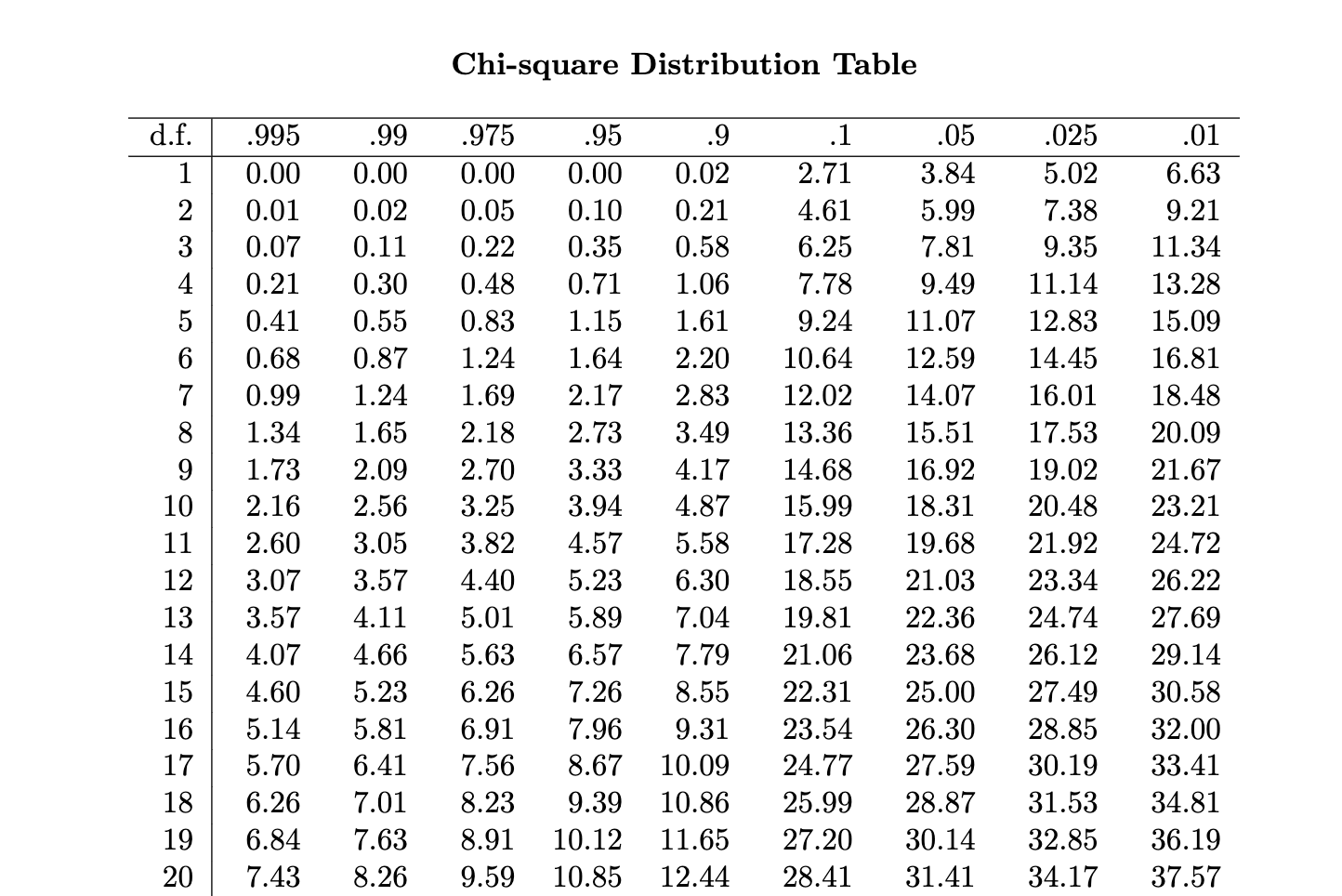Probability & Statistics in Engineering
Fall 2023 - 16 Nov
Recap
The \(100(1-a)\) percent two-sided confidence interval for \(\mu\) is \[\left( \overline{X} - z_{a/2} \dfrac{\sigma}{\sqrt{n}}, \overline{X} + z_{a/2} \dfrac{\sigma}{\sqrt{n}} \right)\]
Also works when \(X\) is not a Gaussian random variable (if sample size \(n\) is large enough)!
Confidence interval of the mean when variance is unknown
- Suppose that \(X_1\), \(X_2\),…, \(X_n\) is a sample from a normal population with unknown \(\mu\) and \(\sigma^2\)
- We cannot use the standard \(Z=\dfrac{\overline{X}-\mu}{\sigma / \sqrt{n}}\)
- However, we can use the variable \(\dfrac{\overline{X}-\mu}{S}\) which follows a t-distribution with \(n-1\) degrees of freedom
Remember that the t-distribution is symmetric

Calculating the interval
\[P \left( -t_{a/2,n-1} < \dfrac{\overline{X}-\mu}{s / \sqrt{n}} < t_{a/2,n-1} \right) = 1 - a\]
\[P \left( \overline{X} - t_{a/2,n-1} \dfrac{S}{\sqrt{n}} < \mu < \overline{X} + t_{a/2,n-1} \dfrac{S}{\sqrt{n}} \right) = 1 - a\]
The \(100(1-a)\) confidence interval for the mean of a random variable that has unknown mean and variance is \[\left( \overline{X} - t_{a/2,n-1} \dfrac{s}{\sqrt{n}}, \overline{X} + t_{a/2,n-1} \dfrac{s}{\sqrt{n}} \right)\]
t-distribution table
 https://www.sjsu.edu/faculty/gerstman/StatPrimer/t-table.pdf
https://www.sjsu.edu/faculty/gerstman/StatPrimer/t-table.pdf
Problem 18.1
A sample of 25 rebars tested for yield strengths yielded \(\overline{x}=37.5\) psi and \(s=3.5\) psi. What is the 95% confidence interval for the mean yield strength?
One-sided confidence interval
If \(\overline{X}\) and \(S\) are the mean and standard deviation of a random sample from a normal distribution with unknown variance, then the upper and lower confidence intervals are respectively \[\left( \overline{X} - \dfrac{S}{\sqrt{n}} t_{a,n-1}, \infty \right)\] \[\left(-\infty, \overline{X} + \dfrac{S}{\sqrt{n}} t_{a,n-1}\right)\]
Also works for an unknown distribution (Thanks CTL!)
Confidence intervals for variance of a normal distribution
- \(X_1\), \(X_2\),…, \(X_n\) is a sample from a normal distribution with unknown \(\mu\) and \(\sigma^2\)
- Confidence interval is constructed from \((n-1) \dfrac{S^2}{\sigma^2}\) follows the chi-square distribution
\[P \left[ \chi^2_{1-a/2,n-1} \leq (n-1)\dfrac{S^2}{\sigma^2} \leq \chi^2_{a/2,n-1} \right] = 1-a\]
\[P \left[ \dfrac{(n-1)S^2}{\chi^2_{1-a/2,n-1}} \leq \sigma^2 \leq \dfrac{(n-1)S^2}{\chi^2_{a/2,n-1}} \right] = 1-a\]
If \(S^2\) is the sample variance from a random sample of \(n\) observations from a normal distribution, then a \(100(1-a)\%\) confidence interval on \(\sigma^2\) is \[\left[ \dfrac{(n-1)S^2}{\chi^2_{a/2,n-1}}, \dfrac{(n-1)S^2}{\chi^2_{1-a/2,n-1}} \right]\]
Calculating \(\chi^2\) values

Problem 18.2
The sample variance of runoff in a river from 25 storms is 0.36 in2. What is the upper 95% confidence bound for the standard deviation of runoff?
Summary

Confidence interval for a population proportion
- Confidence interval for mean of a Bernoulli random variable
- A large random sample of size \(n\) from a population
- \(X\) observations (\(\leq n\)) are of interest
- Then \(\hat{p}=X/n\) is an estimate of the proportion of the population for values of interest
- \(n\) and \(p\) are parameters of the binomial distribution
- We can approximate the binomial with a normal distribution
Normal approximation for a binomial proportion
If \(n\) is large, the distribution of
\[Z=\dfrac{X-np}{\sqrt{np(1-p)}}=\dfrac{\hat{p}-p}{\sqrt{\dfrac{p(1-p)}{n}}}\] is approximately standard normal.
Constructing the confidence interval
\[P(-z_{a/2} \leq Z \leq z_{a/2}) = 1-a\] After rearranging terms \[P\left( \hat{p} - z_{a/2} \sqrt{\dfrac{p(1-p)}{n}} \leq p \leq \hat{p} + z_{a/2} \sqrt{\dfrac{p(1-p)}{n}} \right) = 1 - a\]
Approximate confidence interval on a binomial proportion
If \(\hat{p}\) is the proportion of observations in a random sample of size \(n\) that belongs to a class of interest, an approximate \(100(1-a)\%\) confidence interval on the proportion \(p\) of the population that belongs to that class is \[\hat{p} - z_{a/2} \sqrt{\dfrac{\hat{p}(1-\hat{p})}{n}} \leq p \leq \hat{p} + z_{a/2} \sqrt{\dfrac{\hat{p}(1-\hat{p})}{n}}\]
Choice of sample size
Sample size for a specified error on a binomial proportion \[n=\left( \dfrac{z_{a/2}}{E} \right)^2 p (1-p)\]
If information about \(p\) is unavailable, we can obtain an upper bound of \(n\) \[n=\left( \dfrac{z_{a/2}}{E} \right)^2 (0.25)\]
Approximate one-sided bounds on a binomial proportion
The approximate \(100(1-a)\%\) lower and upper confidence bounds are \[\hat{p} - z_a \sqrt{\dfrac{\hat{p}(1-\hat{p})}{n}} \leq p\] \[p \leq \hat{p} + z_a \sqrt{\dfrac{\hat{p} (1-\hat{p})}{n}}\]
Problem 18.3
At a weight station, the weights of trucks were observed before crossing a bridge. Suppose observations of 30 trucks yielded a mean of 12.5 tons. Assume that the standard deviation of truck weights is known to be 3 tons. What is the two-sided 99% confidence interval for the mean weight of trucks?
How many additional trucks should be observed such that the mean truck weight can be estimated to within \(\pm1.0\) ton with 99% confidence?
Readings
- Sections 7.1-7.2
- Sections 7.3.1-7.3.2 (up to p. 267)
- Section 7.3.3
- Section 7.5
